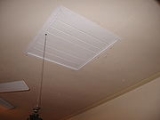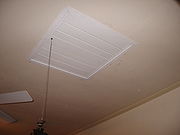
Whole house fan
Encyclopedia

Fan (implement)
A hand-held fan is an implement used to induce an airflow for the purpose of cooling or refreshing oneself. Any broad, flat surface waved back-and-forth will create a small airflow and therefore can be considered a rudimentary fan...
, or exhaust system commonly venting into a building's attic, designed to pull hot air out of the building. It is sometimes confused with an attic fan
Attic fan
An attic fan is a ventilation fan which regulates the heat level of a building's attic by exhausting hot air. A thermostat is used to automatically turn the fan off and on, while sometimes a manual switch is used. An attic fan can be gable mounted or roof mounted. Additional vents are required to...
.
A whole-house fan pulls hot air out of a building and forces it into the attic space. This causes a positive pressure in the attic forcing air out through the gable and/or soffit vents, while at the same time producing a negative pressure inside the living areas which draws cool air in through open windows.
Attic fans, by comparison, only serve to remove some hot air from the attic; no direct cooling effect is provided to the actual living space.
History
Whole-house fans were mainly popularized in the Southern United StatesSouthern United States
The Southern United States—commonly referred to as the American South, Dixie, or simply the South—constitutes a large distinctive area in the southeastern and south-central United States...
through the 1950s-60s, as they were much cheaper and easier to find than air conditioners and still cooled relatively well.
Benefits
A whole-house fan can significantly lower the temperature in a building very quickly, and is much less expensive to operate than air conditioningAir conditioning
An air conditioner is a home appliance, system, or mechanism designed to dehumidify and extract heat from an area. The cooling is done using a simple refrigeration cycle...
. Newer whole house fans can be environmentally friendly and energy efficient additions to house cooling systems. On temperate days they can be turned on to circulate rising hot air out of the house while pulling cool air in. Also new models are quieter and smaller than their older counterparts.
Drawbacks
A major issue to watch for is backdrafts from open flames like water heaters - If the WHF creates a lot of negative pressure it can cause unsealed furnaces to spew toxic carbon-monoxide into the house. Consult an expert HVAC person to address this.Air is drawn into the house through open windows, meaning that the air is unfiltered and may contain pollen or other allergens, which settle out on floors and furniture making the house get dirty fast. This is in contrast to an air conditioner, which mainly circulates air through a heat exchanger
Heat exchanger
A heat exchanger is a piece of equipment built for efficient heat transfer from one medium to another. The media may be separated by a solid wall, so that they never mix, or they may be in direct contact...
.
The fan can also be noisy. The noise is due to the large volume of air handled by such a fan and the speed of the fan blades. Direct drive motors spin the blades faster, producing more noise compared to belt-driven fans, which allow lower fan speeds and less noise. The noise may interfere with other normal household activities such as listening to music, watching television, or conversation.
If not of an insulated design, the fan serves as a large "hole in the ceiling" through which heat will escape during the winter time.
Types
There are two types of fan:- Ceiling Mounted: Mounted on ceiling between the attic and living space.
- Ducted: Remotely mounted away from the ceiling; can exhaust heat from multiple locations; operation is extremely quiet.
Installation
Installing a whole-house fan can be a do-it-yourself project.Attics must be properly vented so that the air is able to escape back outdoors as quickly as it is being blown into the attic. A good rule of thumb is to provide the same amount of venting as the size of the shutter hole in the ceiling.

